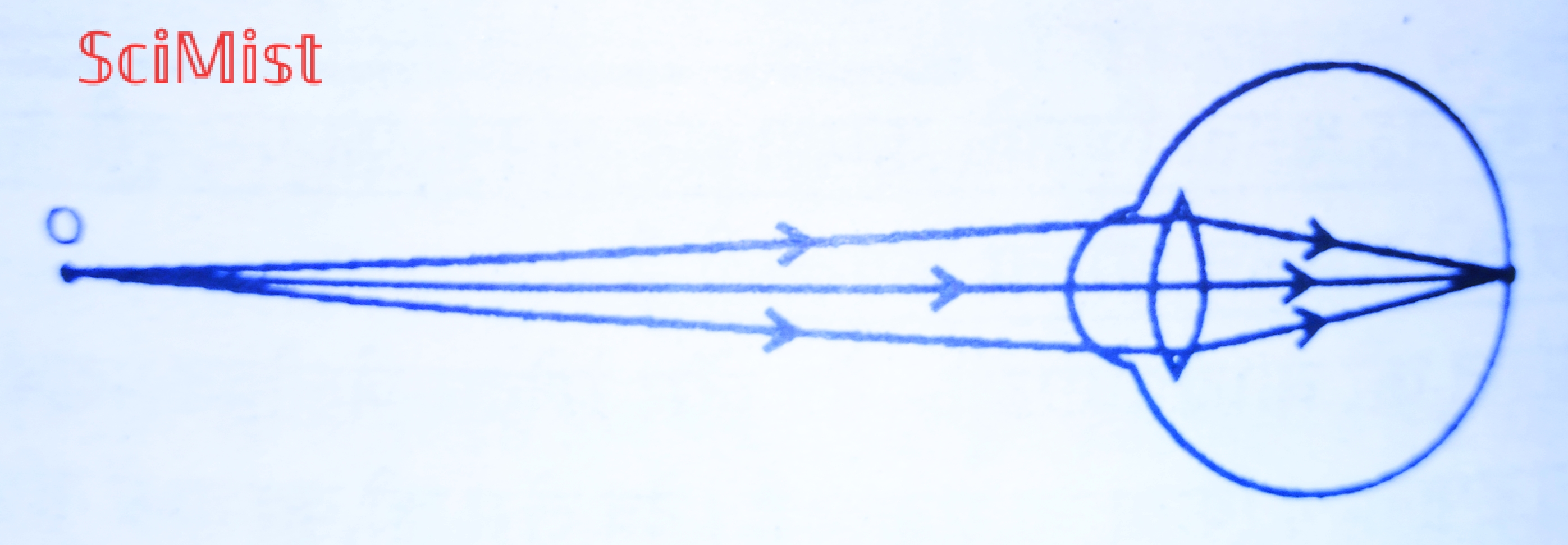Defects of vision and their correction
Defects of vision and their correction:-
Sometimes the eyes can gradually lose their ability to adjust. In such situations, the person is not able to see the objects clearly clearly. Vision becomes blurred due to refractive defects in the eye.
There are mainly three common refractive defects of vision. These defects are
- (i) myopia,
- (ii) hypermetropia and
- (iii) presbyopia
- (iv) Astigmatism
- (v) Cataract
These defects can be rectified by using a suitable spherical lens. We will briefly discuss these defects and their rectification below.
(i) near-sightedness:-
Nearsightedness is also called near-sightedness. A person with nearsightedness can see objects placed close by clearly, but he cannot see objects placed far away clearly. The far-point of such a faulty person does not lie at infinity but comes near the eye. Such a person is able to see clearly only objects placed a few meters away. In an eye with myopia, the image of a distant object is not formed on the retina in front of the retina.
The reasons for the occurrence of this defect are
- (i) excessive curvature of the eye lens or
- (ii) elongation of the eyeball.
 |
| (i) |
Rectification:-
This defect can be rectified by the use of a concave lens (diverging lens) of suitable power. This is shown in Fig. draw the concave image back to the retina of appropriate power lens object comes, and thus this defect gets rectified.
(ii). hyperopia:-
Far-sightedness is also called far-sightedness. A person with long-sightedness can see distant objects clearly, but cannot see closely placed objects clearly. The near-point of such a defected person moves away from the normal near-point (25 cm). Such a person has to keep the reading material at a distance of much more than 25 cm from the eye in order to read clearly clearly. This is because the light rays coming from a nearby object are focused behind the retina, as shown in Fig.
The reasons for the occurrence of this defect are:
- (i) excessive focal length of the eye lens or
- (ii) shortening of the eyeball .
 |
| (i) |
 |
| (ii) |
Rectification :-
This defect can be rectified by using a converging lens (convex lens) of suitable power. This is shown in Fig. . Glasses with convex lenses provide the additional power needed to focus the image of the object on the retina.
(iii) farsightedness:-
With the increase in age, the adjustment capacity of the human eye decreases. The near-point of most individuals shifts away. Without corrective glasses, they find it difficult to comfortably see nearby objects clearly. This defect is called short-sightedness.
Reason :-
It arises due to gradual weakening of the ciliary muscles and loss of flexibility of the crystalline lens. Sometimes a person can have both types of defects in the eyes of myopia and far-sightedness.
Such persons often require bi-focal lenses to see objects clearly. Common types of bifocal lenses have both concave and convex lenses. The upper part is a concave lens. It helps in seeing distant objects clearly. The lower part is a convex lens. It is clearly visible to nearby objects
It helps to see. Nowadays it is possible to correct the defects of vision by contact lens or surgical intervention.
(iv). Astigmatism -
This defect occurs due to irregularity in the roundness of the cornea. In this, the vertical and horizontal lines placed at the same distance are not clearly visible to the person simultaneously.
Correction of astigmatism or aoblinity defect - Cylindrical lens.
(V) . Cataract-
There is a transparent eye lens behind the pupil in the eye, with the help of which the object is visible. As a person ages, the transparency of the eye lens starts losing and its flexibility starts decreasing. Due to this, it starts reflecting light, due to which the object is not clearly visible. This defect is called cataract. Following are the two methods used for the treatment of cataract
- (i) In the first method, the cataract is surgically removed and the patient has to wear thick glasses, which makes the objects appear larger and the field of vision is reduced.
- (ii) There is another modern method in which the eye lens containing the cataract is replaced by an artificial lens called 'intra ocular lens'. In this method, the incision in the eye is less, thick glasses are not required and the field of vision is increased.







0 Comments
Thank you for joining. We Will contact you soon